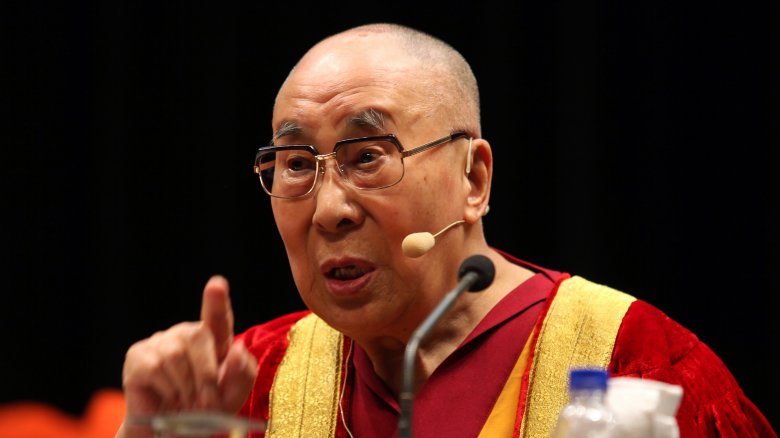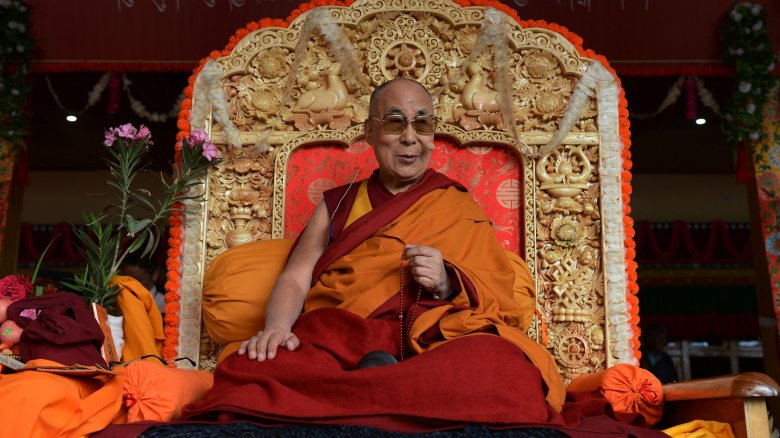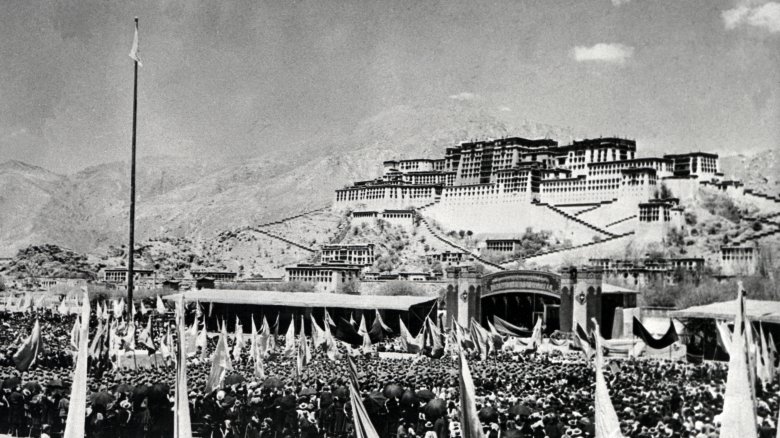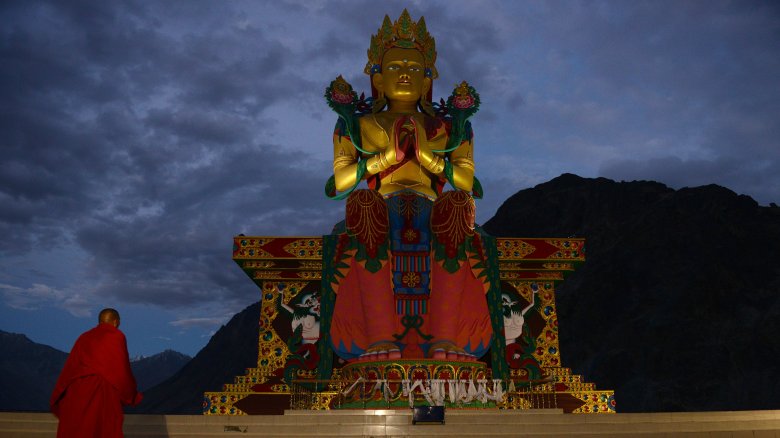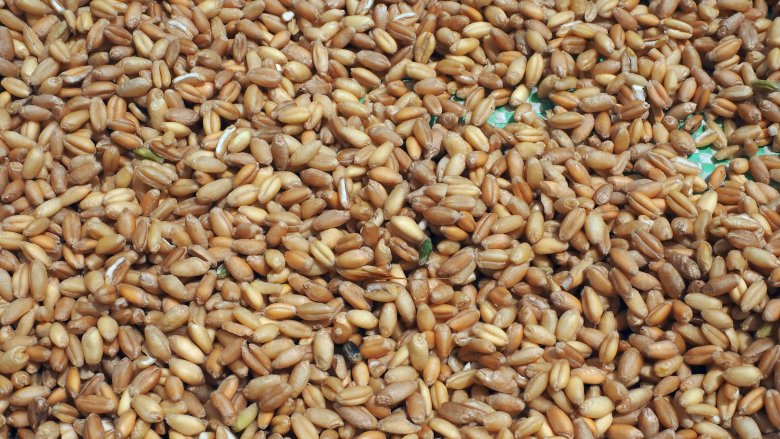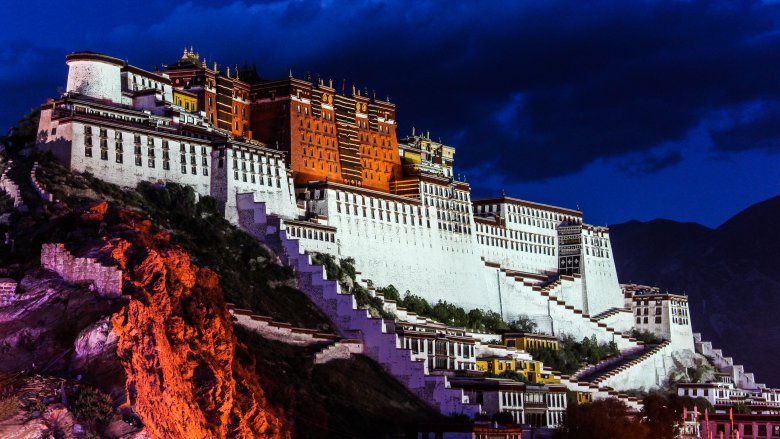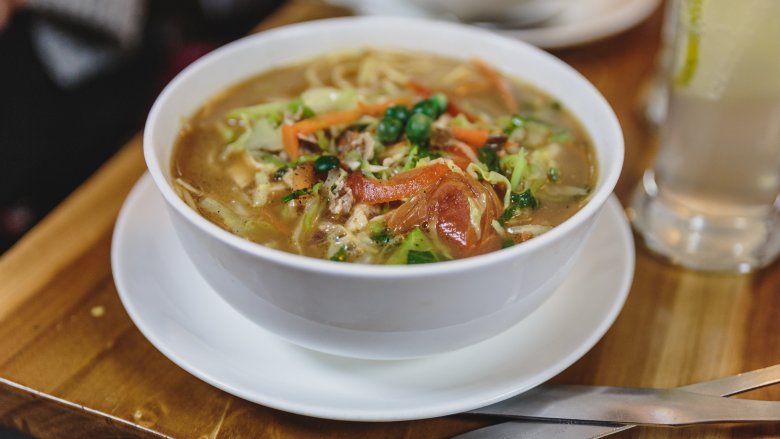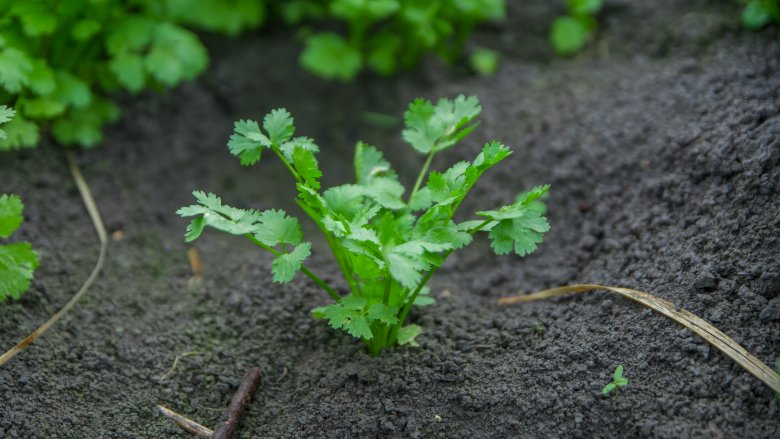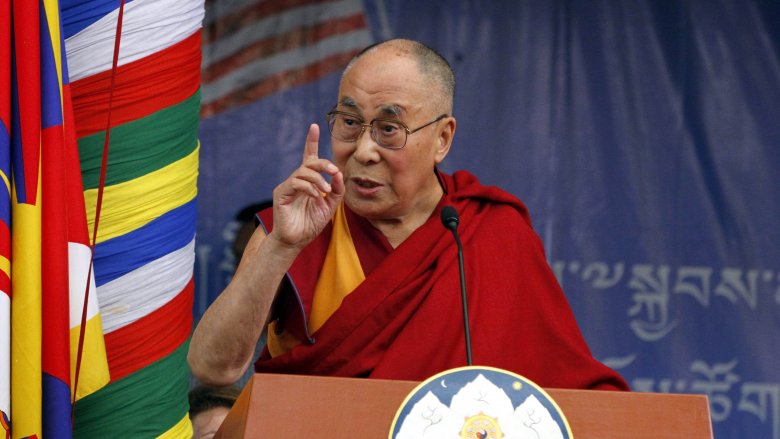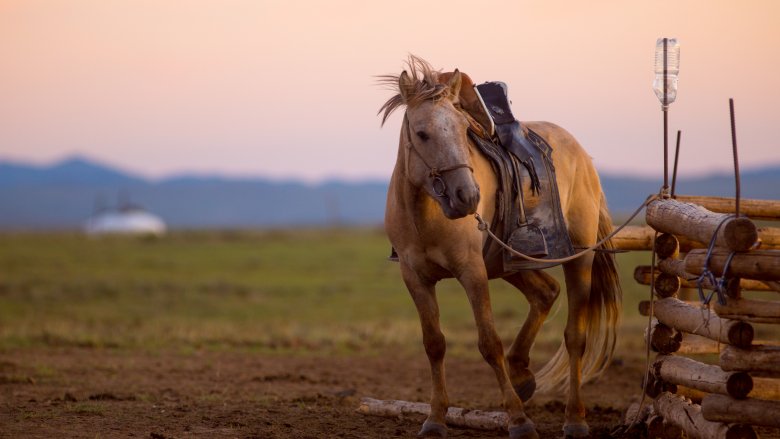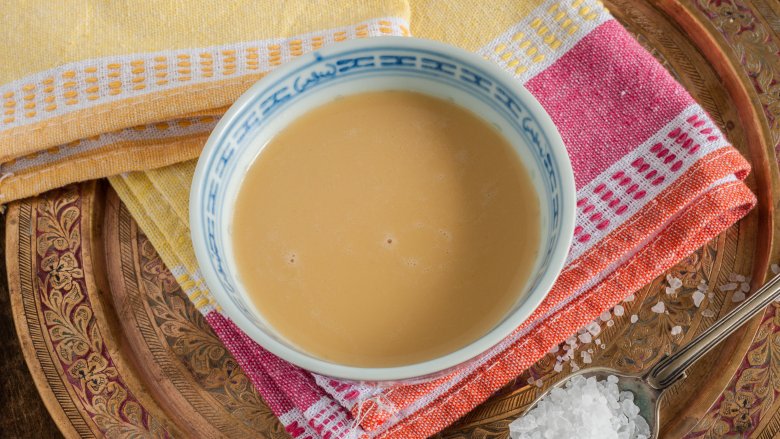This Is What The Dalai Lama Really Eats
Tenzin Gyatso, otherwise known as the 14th Dalai Lama, is one of the world's foremost spiritual and religious leaders. As a leader of the Tibetan strand of Buddhism, he has lived a life almost perpetually in the spotlight, having been enthroned at the age of 4, forced out of Tibet after the 1959 uprising, and awarded the Nobel Peace Prize in 1989.
Despite being famous around the planet, little about the Dalai Lama's actual day-to-day existence is particularly well-known. His diet is certainly one of the facets of his life that receives minimal media attention. Being who he is, however — simultaneously a larger-than-life celebrity and a humble monk — his eating habits are nothing short of fascinating. From his approach to meat, to the strict laws of Buddhism, to the palace gardens which provide his favorite ingredients, these are the ins and outs of the Dalai Lama's meek and mighty diet.
Is he a vegetarian?
The first assumption you might make about the Dalai Lama's eating habits is that the man is a vegetarian. It makes sense, right? One of the principal precepts of Buddhism, after all, is to "abstain from killing." Different sects of Buddhism, however, interpret that law in different ways, and the Dalai Lama's strand (known as the Gelug school) does allow for meat to be eaten by its practitioners.
During his early years in Tibet, the Dalai Lama would have eaten meat as part of his diet because of the country's reliance on consumable livestock in lieu of sufficient vegetable crops. When he fled to India in 1959, he adopted a lacto-ovo vegetarian diet in accordance with the beliefs of many of the country's own Buddhists. Unfortunately, after 20 months, he contracted hepatitis and developed gall bladder disease, and his doctors insisted he resume eating meat for health reasons.
Today, it's difficult to come by meat in the vegetarian monasteries in south India, where he spends most of his time. In 2010, he told NDTV that he usually eats meat once or twice a week, and otherwise lives as a vegetarian. However, when traveling, he does eat meat dishes that are offered to him.
He once had food testers
The 1959 Tibetan Uprising was a rebellion in support of the Dalai Lama, who was the political leader of Tibet at the time, against the People's Republic of China. After a great deal of bloodshed, the Tibetans were defeated and the Dalai Lama forced into exile. His seditious activities quickly made him an enemy of China. It's little surprise, then, that he took no risks when it came to his food.
According to one of the Dalai Lama's former personal chefs, there was "definitely a concern" in Tibet that the Dalai Lama could be poisoned by his enemies. Workers in the palace kitchens were subjected to intensive background checks and tasters would check the food after preparation and prior to being served. These checks had a secondary purpose, too: quality control. Should the tasters find a dish to be unacceptable, it would be returned to the kitchens to be fixed before the Dalai Lama ever set eyes on it.
He doesn't eat dinner
There's plenty to discover about the ways in which the Dalai Lama eats, but you'll probably struggle to find much about his dietary habits post-noon. That's because, according to monastic texts, Buddhist monks and nuns are prohibited from eating solid food after midday. Although it's a controversial view amongs Buddhist practitioners in many ways and for many reasons, it's one that the Dalai Lama certainly adheres to. He takes lunch at 11:30 a.m. and, after that, eats nothing at all until the next morning.
That means no dinner, no afternoon meals and absolutely no snacking whatsoever for the rest of the day. Instead, he spends the afternoons discussing work, holding audiences and conducting interviews. By the time most people are sitting down to enjoy dinner, the Dalai Lama has retired to bed — which isn't much of a surprise when you consider how early he starts his days.
He starts his day in a very Tibetan way
The Dalai Lama's day begins at 3 a.m. He takes a quick shower before praying and meditating until 5 a.m. He then goes for a short walk around his compound (or hops on the treadmill if it's raining) before heading to breakfast. His first meal of the day usually consists of porridge, bread, tea and tsampa. Tsampa is a type of flour made from roasted barley. It's a crucial part of the Tibetan diet and is usually mixed with tea and yak's milk.
We can't emphasize enough just how vital tsampa is to the Tibetan cultural identity — it's used in Buddhist rituals, consumed by athletes, and even gives its name to a Tibetan font. Tibetans are sometimes even referred to as tsampa-eaters, since it's common to all the different factions in Tibetan culture — not too surprising since barley is one of the few crops that does well in the region. It seems only right that it's also how the Dalai Lama begins the day.
His diet in Tibet was home-cooked and homegrown
The Potala Palace in Lhasa was the Dalai Lama's home during his life in Tibet, prior to the 1959 rebellion. Like many palaces, it was well-equipped to deal with the Dalai Lama's culinary needs (few that they were). Among the types of bread baked in the kitchens were korkun, a flatbread similar to naan made from — you guessed it — tsampa, as well as amdo balep, a crusty round loaf popular throughout the country.
The palace also housed a number of greenhouses which provided fresh vegetables throughout the year, most of which would be provided to the Dalai Lama as side dishes during his meals. Some of the vegetables grown there included cauliflower, bitter melon, spinach, tomatoes, and daikon, among others. Although the Dalai Lama now lives in Dharamsala in India, it's likely that he still enjoys many of the same foods and dishes that he used to eat in Tibet.
He enjoys oodles of noodles
Noodles constitute an integral part of the pan-Asian culinary culture, and this is no different in Tibet. According to one former member of the Dalai Lama's kitchen staff, His Holiness was, like many of his fellow Tibetans, a big fan of noodles. One of the dishes he enjoys is thukpa (also know as shey-thuk): a noodle soup which originated in eastern Tibet and northern Nepal, made with pretty much any vegetables available. Among the many specific styles of noodle served in the Dalai Lama's kitchens included gya-thuk, a Chinese noodle and then-thuk, a flat-pulled noodle.
He's said to also be partial to momo, a type of dumpling made from flour and water and filled with meats (such as pork, chicken, goat or buffalo) and vegetables. Shapale is a similar dish — meat contained inside in a fried pastry — that was also frequently served up for His Holiness. Considering the Dalai Lama's schedule, it's likely that these dishes are usually served for lunch, just before midday.
He'll never be a food critic
In 2011, the Dalai Lama made a surprise appearance as a guest judge on Australia's version of MasterChef. Let's just move past the "why" and move on to what actually happened: the show's seven contestants served up a number of (vegetarian) dishes which, due to his beliefs, he refused to rate individually. "My knowledge of these things," he explained, "is very limited. Whatever I get I accept. As a Buddhist monk it is not right to prefer this food or that food."
Despite this, the Dalai Lama did reveal some of his favorite culinary ingredients — including coriander, tofu and mushrooms — and appeared to be unimpressed with the gnocchi he was offered. If nothing else, his cameo on the chef at least offered a rare insight into the particular tastes of the man himself, and that trio of preferred ingredients seems in keeping with everything else we know about the way he eats.
Eating on the road is complicated
The Dalai Lama, of course, doesn't spend all his time at his compound in India. He frequently travels far from home for a whole range of media appearances, interviews and events. Naturally, this means an upheaval in his schedule and a wide variety of different meals to enjoy across the world.
During a visit to Sacramento in 2016, the owners of a local cafe were selected months in advance to prepare a meal for the Dalai Lama. They were forbidden from telling anybody who they'd be cooking for and their food and kitchens were inspected by a bomb squad before any of the staff were allowed in. Extensive background checks were also put into place.
The lunch consisted of a vegan bean soup, salad with tomato and stone fruit and organic duck with a herb sauce and rice. He later showed a particular fondness for the cafe's carrot cake cookies, after ducking away from a meeting with various officials to pinch himself another one.
He endorses horse milk
It probably comes as no surprise to find that the Dalai Lama doesn't drink alcohol. In a 2012 interview he explained that "If your mind, disturbances, unrest, then there's not a choice, relying tranquilizers or drugs or alcohol. My mind, our mind, quite peaceful. So no need these things."
His aversion to alcohol doesn't just stop with himself, however. In 2017, he told John Oliver that he managed to cure the entire nation of Mongolia of alcoholism in the 90s by introducing horse milk to their diets. According to the Dalai Lama itself, he suggested to the Mongolians that they "drink much less vodka" and, instead, begin to drink horse milk. "Since then," he said, "I think majority of Mongolians no longer any drink."
The idea behind that is that airag, a sour, fermented drink made from mare's milk, has a much lower alcohol content than the vodka they were drinking, according to NPR.
Because many Mongolians are Buddhists, they took his message on board. Just how much of an impact the Dalai Lama really had on the country's drinking habits isn't entirely certain, but it's clear that his attitude towards heavy drinking is anything but positive.
He enjoys evening tea, courtesy of the yaks
Although the Dalai Lama is unable to eat after midday, liquids are not off-limits for the rest of the time he's awake. Around 5 p.m. every day — after he's finished with his duties — he sits down for evening tea. Like many eastern Asian countries, tea is a pretty big part of Tibetan life, and one specialty the country enjoys is yak butter tea. It's made by brewing dark tea with salt before adding yak butter, milk, and sometimes tampa. The finished product is creamy, fatty and nutty. It's likely that this is one of the types of tea that the Dalai Lama will enjoy in the evening.
After tea, His Holiness spends a couple of hours praying and meditating, before retiring around 7 p.m. He heads off to his quarters, gets some sleep and then wakes up a few hours later, ready to do the whole thing again.
